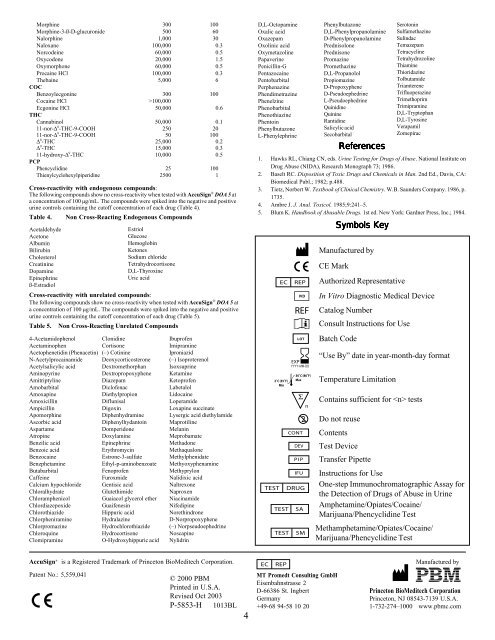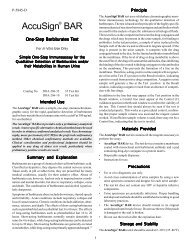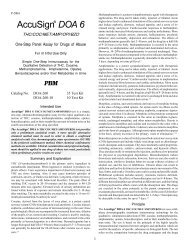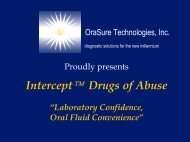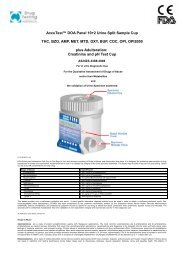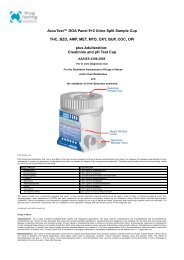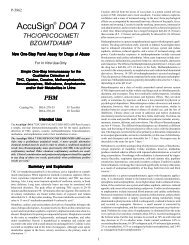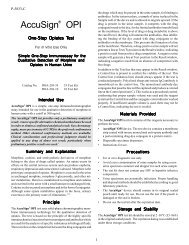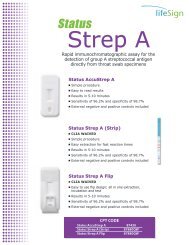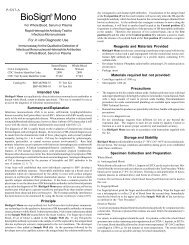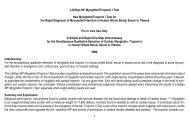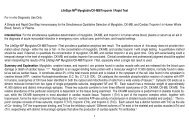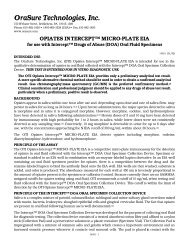AccuSign DOA 5-AMP or MET CE.pdf - Drug Testing
AccuSign DOA 5-AMP or MET CE.pdf - Drug Testing
AccuSign DOA 5-AMP or MET CE.pdf - Drug Testing
You also want an ePaper? Increase the reach of your titles
YUMPU automatically turns print PDFs into web optimized ePapers that Google loves.
M<strong>or</strong>phine 300 100<br />
M<strong>or</strong>phine-3-ß-D-glucuronide 500 60<br />
Nal<strong>or</strong>phine 1,000 30<br />
Naloxane 100,000 0.3<br />
N<strong>or</strong>codeine 60,000 0.5<br />
Oxycodone 20,000 1.5<br />
Oxym<strong>or</strong>phone 60,000 0.5<br />
Procaine HCl 100,000 0.3<br />
Thebaine 5,000 6<br />
COC<br />
Benzoylecgonine 300 100<br />
Cocaine HCl >100,000<br />
Ecgonine HCl 50,000 0.6<br />
THC<br />
Cannabinol 50,000 0.1<br />
11-n<strong>or</strong>-∆ 8 -THC-9-COOH 250 20<br />
11-n<strong>or</strong>-∆ 9 -THC-9-COOH 50 100<br />
∆ 8 -THC 25,000 0.2<br />
∆ 9 -THC 15,000 0.3<br />
11-hydroxy-∆ 9 -THC 10,000 0.5<br />
PCP<br />
Phencyclidine 25 100<br />
Thienylcyclohexylpiperidine 2500 1<br />
Cross-reactivity with endogenous compounds:<br />
The following compounds show no cross-reactivity when tested with <strong>AccuSign</strong> ® <strong>DOA</strong> 5 at<br />
a concentration of 100 µg/mL. The compounds were spiked into the negative and positive<br />
urine controls containing the cutoff concentration of each drug (Table 4).<br />
Table 4. Non Cross-Reacting Endogenous Compounds<br />
Acetaldehyde<br />
Acetone<br />
Albumin<br />
Bilirubin<br />
Cholesterol<br />
Creatinine<br />
Dopamine<br />
Epinephrine<br />
ß-Estradiol<br />
Estriol<br />
Glucose<br />
Hemoglobin<br />
Ketones<br />
Sodium chl<strong>or</strong>ide<br />
Tetrahydroc<strong>or</strong>tisone<br />
D,L-Thyroxine<br />
Uric acid<br />
Cross-reactivity with unrelated compounds:<br />
The following compounds show no cross-reactivity when tested with <strong>AccuSign</strong> ® <strong>DOA</strong> 5 at<br />
a concentration of 100 µg/mL. The compounds were spiked into the negative and positive<br />
urine controls containing the cutoff concentration of each drug (Table 5).<br />
Table 5. Non Cross-Reacting Unrelated Compounds<br />
4-Acetamidophenol<br />
Acetaminophen<br />
Acetophenetidin (Phenacetin)<br />
N-Acetylprocainamide<br />
Acetylsalicylic acid<br />
Aminopyrine<br />
Amitriptyline<br />
Amobarbital<br />
Amoxapine<br />
Amoxicillin<br />
Ampicillin<br />
Apom<strong>or</strong>phine<br />
Asc<strong>or</strong>bic acid<br />
Aspartame<br />
Atropine<br />
Benzilic acid<br />
Benzoic acid<br />
Benzocaine<br />
Benzphetamine<br />
Butabarbital<br />
Caffeine<br />
Calcium hypochl<strong>or</strong>ide<br />
Chl<strong>or</strong>alhydrate<br />
Chl<strong>or</strong>amphenicol<br />
Chl<strong>or</strong>diazepoxide<br />
Chl<strong>or</strong>othiazide<br />
Chl<strong>or</strong>pheniramine<br />
Chl<strong>or</strong>promazine<br />
Chl<strong>or</strong>oquine<br />
Clomipramine<br />
Clonidine<br />
C<strong>or</strong>tisone<br />
(–) Cotinine<br />
Deoxyc<strong>or</strong>ticosterone<br />
Dextrometh<strong>or</strong>phan<br />
Dextropropoxyphene<br />
Diazepam<br />
Diclofenac<br />
Diethylpropion<br />
Diflunisal<br />
Digoxin<br />
Diphenhydramine<br />
Diphenylhydantoin<br />
Domperidone<br />
Doxylamine<br />
Epinephrine<br />
Erythromycin<br />
Estrone-3-sulfate<br />
Ethyl-p-aminobenzoate<br />
Fenoprofen<br />
Furoxmide<br />
Gentisic acid<br />
Glutethimide<br />
Guaiacol glycerol ether<br />
Guaifenesin<br />
Hippuric acid<br />
Hydralazine<br />
Hydrochl<strong>or</strong>othiazide<br />
Hydroc<strong>or</strong>tisone<br />
O-Hydroxyhippuric acid<br />
Ibuprofen<br />
Imipramine<br />
Iproniazid<br />
(–) Isoproterenol<br />
Isoxsuprine<br />
Ketamine<br />
Ketoprofen<br />
Labetalol<br />
Lidocaine<br />
Loperamide<br />
Loxapine succinate<br />
Lysergic acid diethylamide<br />
Maprotiline<br />
Melanin<br />
Meprobamate<br />
Methadone<br />
Methaqualone<br />
Methylphenidate<br />
Methyoxyphenamine<br />
Methyprylon<br />
Nalidixic acid<br />
Naltrexone<br />
Naproxen<br />
Niacinamide<br />
Nifedipine<br />
N<strong>or</strong>ethindrone<br />
D-N<strong>or</strong>propoxyphene<br />
(–) N<strong>or</strong>pseudoephedrine<br />
Noscapine<br />
Nylidrin<br />
D,L-Octopamine<br />
Oxalic acid<br />
Oxazepam<br />
Oxolinic acid<br />
Oxymetazoline<br />
Papaverine<br />
Penicillin-G<br />
Pentazocaine<br />
Pentobarbital<br />
Perphenazine<br />
Phendimetrazine<br />
Phenelzine<br />
Phenobarbital<br />
Phenothiazine<br />
Phentoin<br />
Phenylbutazone<br />
L-Phenylephrine<br />
Phenylbutazone<br />
D,L-Phenylpropanolamine<br />
D-Phenylpropanolamine<br />
Prednisolone<br />
Prednisone<br />
Promazine<br />
Promethazine<br />
D,L-Propanolol<br />
Propiomazine<br />
D-Propoxyphene<br />
D-Pseudoephedrine<br />
L-Pseudoephedrine<br />
Quinidine<br />
Quinine<br />
Rantidine<br />
Salicylic acid<br />
Secobarbital<br />
References<br />
Serotonin<br />
Sulfamethazine<br />
Sulindac<br />
Temazepam<br />
Tetracycline<br />
Tetrahydrozoline<br />
Thiamine<br />
Thi<strong>or</strong>idazine<br />
Tolbutamide<br />
Triamterene<br />
Trifluoperazine<br />
Trimethoprim<br />
Trimipramine<br />
D,L-Tryptophan<br />
D,L-Tyrosine<br />
Verapamil<br />
Zomepirac<br />
1. Hawks RL, Chiang CN, eds. Urine <strong>Testing</strong> f<strong>or</strong> <strong>Drug</strong>s of Abuse. National Institute on<br />
<strong>Drug</strong> Abuse (NIDA), Research Monograph 73; 1986.<br />
2. Baselt RC. Disposition of Toxic <strong>Drug</strong>s and Chemicals in Man. 2nd Ed., Davis, CA:<br />
Biomedical Publ.; 1982; p.488.<br />
3. Tietz, N<strong>or</strong>bert W. Textbook of Clinical Chemistry. W.B. Saunders Company. 1986, p.<br />
1735.<br />
4. Ambre J. J. Anal. Toxicol. 1985;9:241–5.<br />
5. Blum K. Handbook of Abusable <strong>Drug</strong>s. 1st ed. New Y<strong>or</strong>k: Gardner Press, Inc.; 1984.<br />
Manufactured by<br />
<strong>CE</strong> Mark<br />
Symbols Key<br />
Auth<strong>or</strong>ized Representative<br />
In Vitro Diagnostic Medical Device<br />
Catalog Number<br />
Consult Instructions f<strong>or</strong> Use<br />
Batch Code<br />
“Use By” date in year-month-day f<strong>or</strong>mat<br />
Temperature Limitation<br />
Contains sufficient f<strong>or</strong> tests<br />
Do not reuse<br />
Contents<br />
Test Device<br />
Transfer Pipette<br />
Instructions f<strong>or</strong> Use<br />
One-step Immunochromatographic Assay f<strong>or</strong><br />
the Detection of <strong>Drug</strong>s of Abuse in Urine<br />
Amphetamine/Opiates/Cocaine/<br />
Marijuana/Phencyclidine Test<br />
Methamphetamine/Opiates/Cocaine/<br />
Marijuana/Phencyclidine Test<br />
<strong>AccuSign</strong> ® is a Registered Trademark of Princeton BioMeditech C<strong>or</strong>p<strong>or</strong>ation.<br />
Manufactured by<br />
Patent No.: 5,559,041<br />
© 2000 PBM<br />
Printed in U.S.A.<br />
Revised Oct 2003<br />
P-5853-H 1013BL<br />
4<br />
MT Promedt Consulting GmbH<br />
Eisenbahnstrasse 2<br />
D-66386 St. Ingbert<br />
Germany<br />
+49-68 94-58 10 20<br />
Princeton BioMeditech C<strong>or</strong>p<strong>or</strong>ation<br />
Princeton, NJ 08543-7139 U.S.A.<br />
1-732-274–1000 www.pbmc.com


